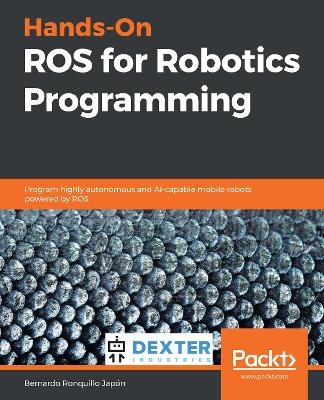
Hands-On ROS for Robotics Programming
Packt Publishing Limited (Verlag)
978-1-83855-130-8 (ISBN)
Take your ROS skills to the next level by implementing complex robot structures in a ROS simulation
Key Features
Learn fundamental ROS concepts and apply them to solve navigation tasks
Work with single board computers to program smart behavior in mobile robots
Understand how specific characteristics of the physical environment influence your robot’s performance
Book DescriptionConnecting a physical robot to a robot simulation using the Robot Operating System (ROS) infrastructure is one of the most common challenges faced by ROS engineers. With this book, you'll learn how to simulate a robot in a virtual environment and achieve desired behavior in equivalent real-world scenarios.
This book starts with an introduction to GoPiGo3 and the sensors and actuators with which it is equipped. You'll then work with GoPiGo3's digital twin by creating a 3D model from scratch and running a simulation in ROS using Gazebo. Next, the book will show you how to use GoPiGo3 to build and run an autonomous mobile robot that is aware of its surroundings. Finally, you'll find out how a robot can learn tasks that have not been programmed in the code but are acquired by observing its environment. You'll even cover topics such as deep learning and reinforcement learning.
By the end of this robot programming book, you'll be well-versed with the basics of building specific-purpose applications in robotics and developing highly intelligent autonomous robots from scratch.
What you will learn
Get to grips with developing environment-aware robots
Gain insights into how your robots will react in physical environments
Break down a desired behavior into a chain of robot actions
Relate data from sensors with context to produce adaptive responses
Apply reinforcement learning to allow your robot to learn by trial and error
Implement deep learning to enable your robot to recognize its surroundings
Who this book is forIf you are an engineer looking to build AI-powered robots using the ROS framework, this book is for you. Robotics enthusiasts and hobbyists who want to develop their own ROS robotics projects will also find this book useful. Knowledge of Python and/or C++ programming and familiarity with single board computers such as Raspberry Pi is necessary to get the most out of this book.
Bernardo Ronquillo Japón is an Internet of Things (IoT) and robotics expert who has worked for top technology companies since 1995, including Instituto de Astrofísica de Canarias, Gran Telescopio Canarias, Altran, and Alestis Aerospace. Using his skills and experience, he founded The Robot Academy, where he develops open source hardware and software solutions for engineers and makers: Social Robot IO (2015), for the stimulation of children with autistic spectrum disorder; Robot JUS (2016), which helps engineers get deeper technical insights with the Robot Operating System (ROS) when using low-complexity hardware; and IIoT All-in-One (2018) as an industrial IoT training package for assisting companies in their digital transformation process.
Table of Contents
Assembling the Robot
Unit testing of GoPiGo3
Getting started with ROS
Creating the virtual two wheeled ROS robot
Simulating the robot behavior in a virtual environment with Gazebo
Programming in ROS: Commands and tools
Robot control and simulation
Virtual SLAM and navigation using Gazebo
SLAM for robot navigation
Applying Machine Learning in Robotics
Machine Learning with OpenAI Gym on ROS
Achieve a goal through Reinforcement Learning
| Erscheinungsdatum | 07.03.2020 |
|---|---|
| Verlagsort | Birmingham |
| Sprache | englisch |
| Maße | 75 x 93 mm |
| Themenwelt | Mathematik / Informatik ► Informatik ► Programmiersprachen / -werkzeuge |
| Informatik ► Theorie / Studium ► Künstliche Intelligenz / Robotik | |
| Informatik ► Weitere Themen ► Hardware | |
| Technik ► Elektrotechnik / Energietechnik | |
| ISBN-10 | 1-83855-130-1 / 1838551301 |
| ISBN-13 | 978-1-83855-130-8 / 9781838551308 |
| Zustand | Neuware |
| Haben Sie eine Frage zum Produkt? |
aus dem Bereich


